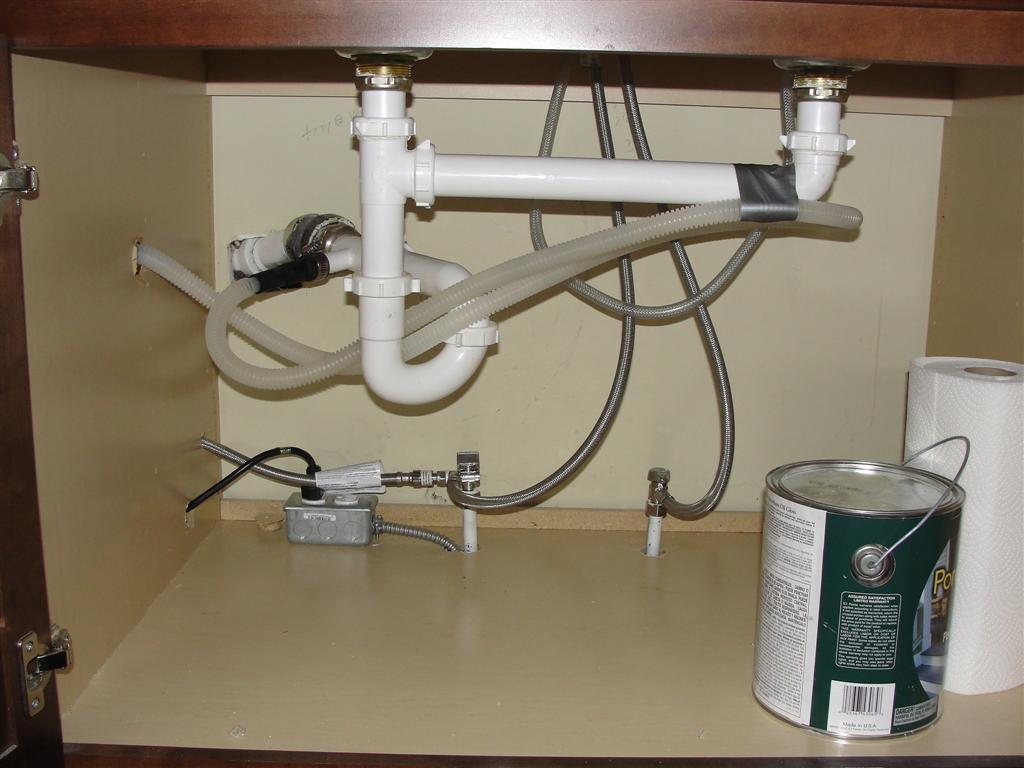An improperly installed drain hose is by far the most common defect that I find with dishwasher installations, but it's also one of the easiest things to get right. In the photo below, which was featured as a Structure Tech Photo of the Day, there are several plumbing defects, two of which are related to the dishwasher drain. Can you spot them?
Wrong side of trap
Problem number one is that the drain is connected to the sewer side of the trap. The water that always sits in the bottom of the P-trap is what prevents sewer gases from coming in to the house. The dishwasher drain must be connected before the P-trap, not after it, which is what was done here. With this improper installation, sewer gases have the potential to come back in to the dishwasher. The diagram below right shows a proper installation.
No high loop
In the diagram above, right, you'll notice that the dishwasher drain makes a high loop underneath the kitchen sink. This is the minimum requirement on every dishwasher drain installation – it's required by every manufacturer of dishwasher, and it's also required by the Minnesota State Plumbing Code (section 4715.1250). An alternative to installing a high loop is to install an air gap at the kitchen sink, but I can't imagine why you would do this if you didn't have to – how ugly. I've heard that these air gaps are required in California. Too bad for them.
Although new dishwashers come from the manufacturer with the drain looped up at the side of the dishwasher, every installation manual still requires this high loop underneath the sink.
I've heard different reasons for why an additional loop is required under the sink, so I decided to contact the manufacturers directly.
I sent out an email to eight dishwasher manufacturers, asking them this question:
"In the installation instructions for all of your dishwashers, a high loop is required on the dishwasher drain. What is the purpose of this? Doesn’t the high loop that is incorporated in to the side of the dishwasher achieve the same thing? Any insight or commentary in to this matter would be greatly appreciated."
Here are the responses I received:
- Kenmore: "The high loop or air gap must be used to prevent potential backflow contamination of the dishwasher. Local plumbing codes generally dictate the requirements in your area. Section 807.4 of the Uniform Plumbing Code states: "No domestic dishwashing machine shall be directly
connected to a drainage system or food waste disposer without the use of an
approved dishwasher airgap fitting on the discharge side of the dishwashing
machine. Listed airgaps shall be installed with the flood level (FL) marking at
or above the flood level of the sink or drainboard, whichever is higher, or
separately trapped with the airbreak located on the stand pipe." - GE: "If an air gap is not required, the drain hose must have the high loop from the floor to prevent backflow of water into the dishwasher or water siphoning out during operation."
- Bosch: The high loop in the drain hose of your dishwasher is to keep water from settling in the hose if it were hanging down any lower or horizontally. This keeps the drain hose dried out and keeps any odors from backing up into the dishwasher.
- Viking: In testing our dishwashers, we have found that the additional high loop in the back of the dishwasher is required for proper draining of the water. We have seen when this piece is not applied that over time the consumer will have issues with the water back up and causing issues with proper drainage and water pooling in a particular area.
- Maytag: No response after 29 days. Boo.
- Whirlpool: No response after 29 days. Boo.
- Amana: No response after 29 days. Boo.
To summarize, the reasons for the high loop are to prevent potential backflow of water in to the dishwasher and to prevent improper drainage of water. Even though dishwashers come from the factory with the drain looped up high against the side of the dishwasher, this is not an acceptable substitute for the high loop underneath the kitchen sink.
In Minneapolis, the lack of a properly installed high loop under the kitchen sink requires repair for their Truth-In-Sale of Housing evaluations.
Reuben Saltzman, Structure Tech Home Inspections - Email - Minneapolis Truth In Housing









This site water plumbing machines seen like very helpful and used for big industries…